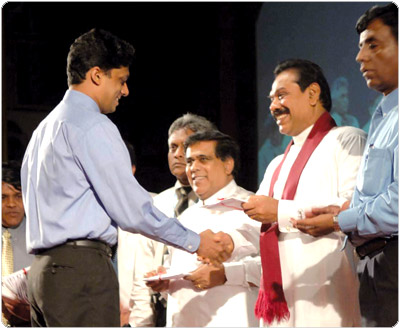Unprecedented growth in healthcare services
By Jaliya WIJEYEKOON
|

The refurbished Anuradhapura Hospital |
Sri Lanka occupies a very prominent
place among countries in the South Asian Region and most of other
countries in the provision of healthcare services. Although Sri Lanka
possesses a relatively low per capita income in comparison to other
developed and developing countries, the indices used for the assessment
of the quality of health services, including life expectancy and the
maternal and child mortality rates indicate that Sri Lanka is always at
the forefront in the health field. That was possible mainly due to
policies and other activities followed by successive governments after
independence for the maintenance of free health services in the country.
|

President Mahinda Rajapaksa handing over letters of
appointment to new doctors |
With the advent of the present government in 2005 under the
leadership of President Mahinda Rajapaksa it is admirable to see the
vast strides made in the health sector in all related areas. It is quite
evident from the budgetary allocations since 2005-2011 how the present
government had initiated different programs and continued to enhance the
health and well-being of the nation amidst a number of financial
constraints.
President Mahinda Rajapaksa has accepted through the ‘Mahinda
Chinthana’ program that the government is committed to strengthen the
healthcare system and ensure the delivery of free healthcare services to
the needy people.
Those achievements made amidst a number of challenges have been
highly praised by the international community. The government with a
clear vision of the future requirements of health, has launched a number
of programs under Mahinda Chinthana Idiri Dekma for the development of
human and physical resources of health to a specific plan and the
ministry of health has taken the responsibility of implementing such
programs.
The minister of health Maithreepala Sirisena has restructured the
entire health ministry mechanism to provide a better health service to
the nation.
Master plan
President Rajapaksa’s Government has worked according to a strategic
master plan since 2005 to promote the health sector identifying relevant
areas and giving priority to most vital segments of the sector.
Development activities of the Health Ministry have been carried out
mainly under three areas-human resources development, material
development and infrastructure development.
The Rajapaksa Government since 2005 had spent huge amounts of funds
for the human resource development of the health sector. The recruitment
of employees for various categories has increased at an unprecedented
rate amidst financial constraints.The intake of medical students to all
faculties has been increased as a long-term measure to meet the future
demand in consultation with the Education Ministry. Over the last few
years a substantial number of doctors has been sent abroad for
specialised training at Government expenditure.
More than 15,000 nurses have been recruited during the last few years
and a few batches have already completed their training and posted to
various hospitals in the country. An allowance of Rs. 20,000 per trainee
is paid during their training period and all facilities are given to
them in addition to the comprehensive training imparted on them on which
the ministry is spending a large amount of money.
In addition to the doctors, and nurses various other supportive staff
members such as radio-graphers pharmacists, and therapists were also
recruited to meet the necessities in most of the hospitals. Setting up
of new hospitals and development of existing hospitals is a major
venture carried out by the Rajapaksa Government to promote the health of
the nation during the last few years.
New hospital buildings, such as wards, theatres, halls, laboratories,
quarters for doctors were provided. New hospitals were set up in densely
populated areas to look after the health of the people.
The hospitals in Anuradhapura, Polonnaruwa, Jaffna, Badulla, and
Ambalangoda are now provided with all facilities for any type of ailment
and people in those areas do not have to travel anywhere for treatment.
The Health Ministry has spent a colossal amount of funds to upgrade
these hospitals.
Facilities
MOH offices, rural hospitals, estate hospitals, have been provided
with all facilities to cater to the needs of the people of the area.
All government hospitals in the island are now geared to cater to all
the medical needs of the public. Latest sophisticated modern medical
equipment are supplied to all general hospitals with specialist doctors
for any ailment.
A number of structural changes were recently effected by the present
government in the administrative sphere of the Health Ministry to
streamline the services.
Some of the hospitals which came under the purview of line ministry
of the Provincial Councils, were absorbed to the central government
thereby improving the standards of the hospitals. Regular progress
review committee meetings are conducted with the participation of the
ministers of health with Provincial Council Health Ministers to assess
the progress made in discharging an effective service to the nation. The
prevention of epidemics is another important area that the Ministry is
working round the clock spending a large amount of funds for the benefit
of the public.
The recent dengue epidemic which created havoc in the country has
been curbed to a great extent with a comprehensive program of work
involving all its stakeholders. It is commendable to see how a
Presidential Task Force was formed with the intervention of President
Rajapaksa.
Seven ministries are now working as a single unit to control the
epidemic. In addition to the colossal budgetary allocations to improve
the health sector by the government during the last few years, a large
number of foreign funded projects had been carried out in a number of
hospitals in the island.
The five-year period from 2005 to 2010 could be considered the most
productive period in the improvement of health care facilities to the
nation since independence. |

